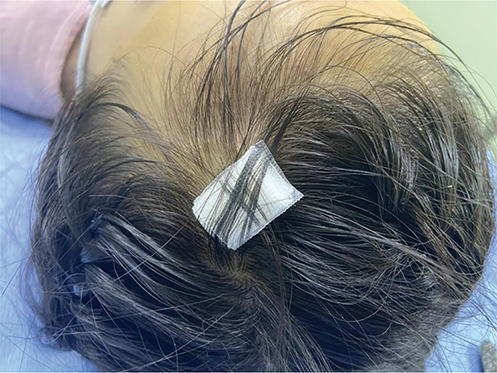SHORT COMMUNICATION
A Simple Feasible Method for Fixing Scalp Dressings
Xiao-Yan YANG1, Xiao-Xiao SHI1 and Ying-Ying XIANG2*
1Department of Dermatology, Yan′an Hospital Affiliated to Kunming Medical University, Kunming, and 2Department of Stomatology, Yan′an Hospital Affiliated to Kunming Medical University, Kunming, China. *E-mail: 25591394@qq.com
Citation: Acta Derm Venereol 2024; 104: adv42129. DOI: https://doi.org/10.2340/actadv.v104.42129.
Copyright: © 2024 The Author(s). Published by MJS Publishing, on behalf of the Society for Publication of Acta Dermato-Venereologica. This is an Open Access article distributed under the terms of the Creative Commons Attribution-NonCommercial 4.0 International License (https://creativecommons.org/licenses/by-nc/4.0/).
Submitted: Sep 29, 2024. Accepted after revision: Oct 30, 2024. Published: Nov 20, 2024.
Competing interests and funding: The authors have no conflicts of interest to declare.
INTRODUCTION
The bandaging and fixation of postoperative dressings after scalp surgery are challenging tasks. The previously recommended bandaging method include: (a) hair tie-over dressing: the hair from each side of the wound is secured over the gauze with an elastic band (1); (b) fixation of head dressing gauzes with paper clips (2); (c) dressing gauzes anchored to elastic tape using silk sutures for a sturdy head bandage (3); (d) affixing a scalp dressing with hairpins (4).
However, we thought these time-consuming to implement, can cause discomfort to patients, make it difficult to grasp key points, and have a negative impact on the aesthetics after scalp surgery. Therefore, it is necessary to consider an easy to learn and simple scalp wound dressing method that is more easily promoted and used by doctors.
MATERIALS AND METHODS
We found that a small amount of hair on both sides of the wound can be used as a fixed support point. The wound dressing and supporting hair can be secured together with tape to stabilize the dressing. The specific method is to cross the hair on both sides of the wound on the surface of the dressing, and then use tape of the same length as the dressing to stick it to the hair surface to fix the dressing stably (Fig. 1). This method can avoid excessive pulling of hair around the wound. The tape only touching the surface of the dressing and a small amount of hair is not easy to pollute, and the operation is extremely simple.

Fig. 1. Postoperative crossing of hair to fix dressing.
DISCUSSION
We believe our simple feasible method for fixing scalp dressings is a method worth promoting. The advantages of this dressing method post minor scalp surgery include:
- The dressing needs only to cover the surgical incision, which ensure that the patient’s postoperative appearance is not compromised.
- The adhesive tape application is limited to dressings and is not applied extensively over hair, thus preventing its retention in hair.
- The small amount of hair used as the fixed support can be cut or can continue to be used as the fixed support during the next dressing change, without affecting the patient’s appearance or causing pain.
- The procedure is easy to perform as compared with other fixed methods, is comfortable, and ensures normal postoperative appearance.
ACKNOWLEDGEMENT
Funding sources: Health Research Project of Kunming Municipal Health Commission (2022-22-01-001), Yunnan Provincial Department of Education Science Research Fund Project (2023Y0671), Kunming Health Technology Talent Training Project (2023-SW (Reserve)-2).
REFERENCES
- Langtry JA, Carruthers A, Kozdron A. Hair tie-over dressing: a simple dressing for hair-bearing scalp wounds. Dermatol Surg 1998; 24: 679–680. https://doi.org/10.1111/j.1524-4725.1998.tb04227.x
- Bu W, Zhang Q, Fang F, Zhang L. Fixation of head dressing gauzes with paper clips is similar to and better than using tape. J Am Acad Dermatol 2019; 81: e95–e96. https://doi.org/10.1016/j.jaad.2018.10.046
- Afra TP, Hafi B, Razmi TM. Dressing gauzes anchored to elastic tape using silk sutures (“hammock dressing”) for a sturdy head bandage. J Am Acad Dermatol 2020; 82: e243–e245. https://doi.org/10.1016/j.jaad.2020.01.081
- Zhang J, Wang Y, Zhang W, Lu H. Affixing a scalp dressing with hairpins. Cutis 2023; 112: 99–100. https://doi.org/10.12788/cutis.0819